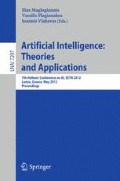Abstract
We present an integer linear programming model of word sense disambiguation. Given a sentence, an inventory of possible senses per word, and a sense relatedness measure, the model assigns to the sentence’s word occurrences the senses that maximize the total pairwise sense relatedness. Experimental results show that our model, with two unsupervised sense relatedness measures, compares well against two other prominent unsupervised word sense disambiguation methods.
Access this chapter
Tax calculation will be finalised at checkout
Purchases are for personal use only
Preview
Unable to display preview. Download preview PDF.
References
Agirre, E., Lopez de Lacalle, O.: Supervised domain adaption for word sense disambiguation. In: EACL (2009)
Agirre, E., Soroa, A.: Personalizing PageRank for word sense disambiguation. In: EACL (2009)
Florian, R., Cucerzan, S., Schafer, C., Yarowsky, D.: Combining classifiers for word sense disambiguation. Natural Language Engineering 8(4), 327–341 (2002)
Gabrilovich, E., Markovitch, S.: Computing semantic relatedness using Wikipedia-based explicit semantic analysis. In: IJCAI (2007)
Lesk, M.: Automated sense disambiguation using machine-readable dictionaries: How to tell a pine cone from an ice cream cone. In: SIGDOC (1986)
Manning, C., Schutze, H.: Foundations of Statistical NLP. MIT Press (2000)
Mihalcea, R., Csomai, A.: SenseLearner: Word sense disambiguation for all words in unrestricted text. In: ACL (2005)
Mihalcea, R., Tarau, P., Figa, E.: PageRank on semantic networks with application to word sense disambiguation. In: COLING (2004)
Montoyo, A., Suarez, A., Rigau, G., Palomar, M.: Combining knowledge-and corpus-based word-sense-disambiguation methods. JAIR 23, 299–330 (2005)
Navigli, R.: Online word sense disambiguation with structural semantic interconnections. In: EACL (2006)
Navigli, R.: Word sense disambiguation: A survey. ACM Computing Surveys 41(2), 10:1–10:69 (2009)
Navigli, R., Lapata, M.: Graph connectivity measures for unsupervised word sense disambiguation. In: IJCAI, pp. 1683–1688 (2007)
Palmer, M., Dang, H., Fellbaum, C.: Making fine-grained and coarse-grained sense distinctions, both manually and automatically. NLE 13(2), 137–163 (2007)
Ponzetto, S., Strube, M.: Knowledge derived from Wikipedia for computing semantic relatedness. J. of Artificial Intelligence Research 30, 181–212 (2007)
Quillian, R.: The teachable language comprehender: a simulation program and theory of language. Communications of ACM 12(8), 459–476 (1969)
Resnik, P.: Using inform. content to evaluate semantic similarity. In: IJCAI (1995)
Schütze, H.: Automatic word sense discrimination. Computational Linguistics 24(1), 97–123 (1998)
Sinha, R., Mihalcea, R.: Unsupervised graph-based word sense disambiguation using measures of word semantic similarity. In: IEEE ICSC (2007)
Tsatsaronis, G., Varlamis, I., Nørvåg, K.: An Experimental Study on Unsupervised Graph-based Word Sense Disambiguation. In: Gelbukh, A. (ed.) CICLing 2010. LNCS, vol. 6008, pp. 184–198. Springer, Heidelberg (2010)
Tsatsaronis, G., Varlamis, I., Vazirgiannis, M.: Text relatedness based on a word thesaurus. JAIR 37, 1–39 (2010)
Tsatsaronis, G., Vazirgiannis, M., Androutsopoulos, I.: Word sense disambiguation with spreading activation networks generated from thesauri. In: IJCAI (2007)
Turney, P.D.: Mining the Web for Synonyms: PMI-IR versus LSA on TOEFL. In: Flach, P.A., De Raedt, L. (eds.) ECML 2001. LNCS (LNAI), vol. 2167, pp. 491–502. Springer, Heidelberg (2001)
Author information
Authors and Affiliations
Editor information
Editors and Affiliations
Rights and permissions
Copyright information
© 2012 Springer-Verlag Berlin Heidelberg
About this paper
Cite this paper
Panagiotopoulou, V., Varlamis, I., Androutsopoulos, I., Tsatsaronis, G. (2012). Word Sense Disambiguation as an Integer Linear Programming Problem. In: Maglogiannis, I., Plagianakos, V., Vlahavas, I. (eds) Artificial Intelligence: Theories and Applications. SETN 2012. Lecture Notes in Computer Science(), vol 7297. Springer, Berlin, Heidelberg. https://doi.org/10.1007/978-3-642-30448-4_5
Download citation
DOI: https://doi.org/10.1007/978-3-642-30448-4_5
Publisher Name: Springer, Berlin, Heidelberg
Print ISBN: 978-3-642-30447-7
Online ISBN: 978-3-642-30448-4
eBook Packages: Computer ScienceComputer Science (R0)

